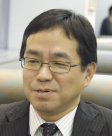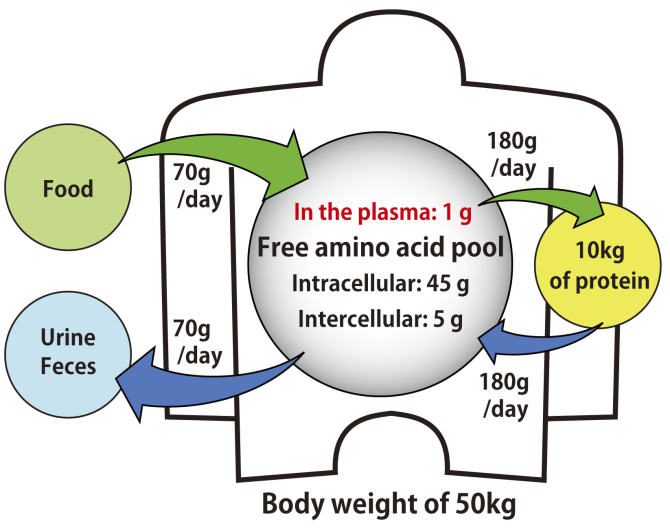
Future of Life Science Pioneered by Biosupercomputing
It is expected that new
possibilities in nutrition science
and health control will be opened
up by simulation science

EXECUTIVE PROFESSIONAL Health infomatics DEPT., Ajinomoto Co., Inc. Toshihiko Ando
■A new viewpoint born from simulation
━ You have played a central role in the Life Sciences Application Subcommit tee Meeting of the Industrial Committee for Supercomputing Promotion. Have you always been interested in simulation?
●Ando(dispensed with the Mr. and Mrs) Describing the present state of affairs, it can be said that there are very few cases using simulation in the food industry. For example, in heating frozen food, simulation has been performed to develop the form of tray with the best heat efficiency, and simulation has been used to design the manufacturing processes for foods. However, the Research and Development Division of this company is addressing research and development on an “Amino index” useful for health control by measuring the concentrations of amino acids in the blood. This aims at development of new products using amino acids and at new commercial prospects such as providing information useful for health checks and diagnosis of disease, and prediction of drug efficacy and adverse reactions, based on an idea that health conditions can be analyzed using the pattern in the concentration of amino acids, the center of the metabolite network (aminogram), as an index. I am also engaged in this research and development, in which I thought that I can make good use of simulation. For example, the pattern of amino acids in the body changes when we are getting sick. The reason for this change has not been clarified, but the amino acid balance changes because a certain amino acid increased or another amino acid decreases. It is very difficult to understand the change in balance and its mechanism, but it may go smoothly by using simulation. So, I am looking forward to doing research and development on a metabolism simulator at the cellular level, which has been progressing in the field of biosupercomputing.
━ It’s certainly different from medical science, but it may be possible to utilize simulation for nutrition science and development of health foods.
●Ando I may get scorched by the doctors of nutrition science, but I think
that the teaching in nutritional science has not changed much from the
past. I think that it is very important that a new viewpoint using simulation is
created in the field of nutrition science.
As written in the book by Mr. Shinichi Fukuoka, “Dynamic Equilibrium,” the
human body is totally replaced in 3 or 4 months. As concerns amino acids,
firstly, we take protein from foods in an amount of about 70 g per day. It is
digested, decomposed and absorbed into the blood, and by this, about 180
g is synthesized into proteins such as for muscle tissue. On the other hand,
about 180 g is decomposed to amino acids, and about 50 g is pooled as
free amino acids in the body, 45 g of which exists in cells, about 5 g of which
exists in the intercellular space and about 1 g of which exists in the blood.
They are in this kind of balance. In this cycle, moreover, 70 g is discharged
together with feces and urine through the blood (see Figure). Moreover,
this cycle is totally renewed in 3 or 4 months. Amino acids which we ate
are not used as amino acids as they are, but metabolized in various ways to
become organic acids or amines and taken into the body. There is such a
fast metabolic turnover, but the form of the human body does not change.
The same form can be maintained, that is, equilibrium is maintained. It is
a dynamic equilibrium. I myself think that amino acids are present at the
center of this dynamic equilibrium, and in any case, the protein turnover
is very important. It can be said that it supports the equilibrium of body.
The turnover is very fast, but there is only 1 g of amino acids in the blood.
A person weighing 50 kg has about 10 kg of muscles but has only 1 g in the
blood. One part per 10 thousand. Even so, a constant level is maintained,
and amino acids are maintained in equilibrium. It may be good if nutrition
science were not limited to calories by a thorough understanding of
something like this.
My other interest is chrononutrition. In a simple term, nutrients are
different according to the time of intake, and the timing is important. For
drugs, there are some doctors studying when a drug shows least adverse
reactions and highest efficacy, before sleeping at night or at waking up in
the morning, considering the pattern of drug metabolism. Similarly, there
are some doctors of nutrition science studying when and how to take foods
effectively to maintain health in balance. I feel that simulation may be useful
in the field of new nutrition science to which the concept of time is added.
If we can simulate the change in the metabolism of the human body with
time when a perturbation like eating some food occurs, we may be able to
provide information concerning the nutritional management suitable for a
person, such as what nutrients are the most efficient and good for the body
and when they should be taken. Moreover, nutrition and metabolism are
very complex, and there are many molecules involved, so it is very difficult
to control them. Their balance may be changed by something, but it is
important to maintain it. If such a thing were clarified by simulation, I think
that it would be very useful for many reasons.
■Health simulator can also be realized
━ The use of simulation in nutritional management is also a new viewpoint.
●Ando Mainly in Europe, nutritional societies around the world are
addressing a campaign called “Fight against all malnutrition”. Malnutrition is
considered to be a problem of developing countries. Apparently there are a
many cases leading to malnutrition because of poverty and food shortage,
but in countries like Japan, there may still be some malnutrition. There are a
many elderly people with malnutrition. For example, there are many people
who cannot eat because of decreased digestive function and loss of desire
to eat. Moreover, there are some people who come to suffer malnutrition
due to dietary limitation for lifestyle-related diseases. Simulation may be
used for research concerning what parameters we should control to prevent
malnutrition.
It is of course important to cure illness, but I think it is very important to
maintain the body in health as long as possible. In this respect, I think that
simulation can help. For example, health care to identify some parameter
such as a health barometer and to provide a method to maintain individual
health may be acceptable. It is like a dream, but I hope for a system in
which, if my parameter data is determined every 3 months or 6 months and
analyzed, various prescriptions to maintain my health would be identified.
If this were made visible, it might be more interesting. How about such a
health simulator? If several tens of millions of people could register to collect
data, a health trend might emerge, and we might be able to issue a “health
forecast” that it is necessary to prepare for some disease in the future. It
may be interesting if the whole world of industry were to address such an
attempt.
■The world of industry may move if we can show evidence of success.
━ Do you feel that the reaction of the world of industry to simulation is still weak?
●Ando I think so. I think it is different depending on the field. There are
many companies working hard in the field of making things. Generally
speaking, however, in order that simulation is utilized in the world of
industry, I think it is very important to achieve not only academic results
but also economic effects. Unless everybody understands that major
successes will be obtained by using simulation, they may think that “it may
be difficult to use it.” I think it is necessary to show some example of a major
economic success. Every category has a rule for success. Unless we can show
a paradigm of success cases using supercomputers to become winners, I feel
that the number of people who use supercomputers will not much increase.
A lot of success cases are not required. However, it might be OK if there were
only one case of major success. I hope that the present field of life sciences
will reveal such a case. If we focus on possible cases for promotion instead of
wide and shallow promotion and achieve results which might turn out to be
a breakthrough, the awareness of the world of industry may change.
Moreover, it may be difficult to use supercomputers abruptly. I think that the
hurdle is too high. We need a certain mechanism like a “trial system.” In such
a context, it is necessary to design a way of collaboration between industry
and the academic world. It may be necessary to examine how each area of
specialty is used amongst ourselves, such that simulation is entrusted to the
academic world.
Dynamic equilibrium of amino acid metabolism: Proteins in the body
are replaced with amino acids, etc. taken from foods in a few months.

BioSupercomputing Newsletter Vol.4
- SPECIAL INTERVIEW
- In order to change from observation-type medical practice focusing on experience to prediction-type medical practice to construct the base of theoretical medicine
Professor, Department of Internal Medicine (Cardiovascular Medicine), Director of the Metabolic Disease Research Center, Bio-Research Medical Center, Tokai University Graduate School of Medicine, and Director, Department of Metabolic System Medicine, Tokai University General Medical Laboratory Shinya Goto - It is expected that new possibilities in nutrition science and health control will be opened up
by simulation science
EXECUTIVE PROFESSIONAL Health infomatics DEPT., Ajinomoto Co., Inc. Toshihiko Ando
- Report on Research
- The functions of a multidrug discharging transporter were verified by coarse graining molecular simulation (Molecular Scale WG)
Graduate School of Science, Kyoto University Shoji Takada / Xin-Qiu Yao / Hiroo Kenzaki - Cell simulation considering time-space (Cell Scale WG)
Computational Science Research Program, RIKEN Yasuhiro Sunaga - Development of HIFU simulator for non-invasive treatment with high-intensity focused ultrasound (Organ and Body Scale WG)
VCAD System Research Program, RIKEN Kohei Okita - PLATO: Platform for a collaborative brain system modeling toward development of large scale mathematical model.(Brain and Neural WG)
①Computational Science Research Program, RIKEN
②Brain Science Institute, RIKEN
Keiichiro Inagaki①/ Takayuki Kannon②/ Nilton L. Kamiji②/ Koji Makimura②/ Shiro Usui ①②
- Report
- Report on the workshop in BMB2011 (Joint Meeting of the 33rd Congress of the Molecular Biology Society of Japan and the 83th Congress of the Japanese Biochemical Society)
- Winter School 2011 for the Integrated Simulation of Living Matter
Computational Science Research Program, RIKEN Yasuhiro Ishimine (Organ and Body Scale WG)
The Institute of Medical Science, The University of Tokyo Hidetoshi Urakubo (Brain and Neural WG)
Computational Science Research Program, RIKEN Yasuhiro Sunaga (Cell Scale WG)
Computational Science Research Program, RIKEN Gen Masumoto (High-Performance Computing Team)
Computational Science Research Program, RIKEN Keiji Misawa (Data Analysis Fusion WG)
Computational Science Research Program, RIKEN Hisayuki Miyashita (Molecular Scale WG) - Winter School 2011 for the Integrated Simulation of Living Matter
